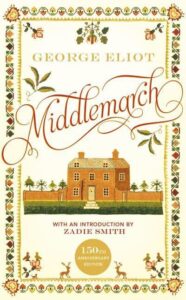Social Classes and Affecting Opportunities:
Middlemarch and Equality
By Zeynep Nehir Günal

Middlemarch by George Eliot is a renowned novel first published in 1871-1872. Set in the fictional town of Middlemarch during 1829-1832, the story follows a web of interconnected characters as they navigate personal and societal transformations. Through its exploration of themes like the role of women in society, social classes, and social responsibility, the novel has rightfully earned its place as a masterpiece of Victorian literature.
Within the pages of “Middlemarch,” we witness the portrayal of social hierarchies and class differences in 19th-century England, shedding light on the distinct divisions and inequalities prevalent among various classes. The novel vividly illustrates how social class can profoundly impact opportunities, shape the treatment of individuals in society, and present challenges for those seeking to transcend the limitations imposed by these social structures.
One character, Dorothea, hails from an aristocratic family, granting her privileges and resources that she aspires to utilize for positive change. However, she finds herself frustrated as her social circle becomes a barrier to her personal growth and limits her interactions with individuals from different backgrounds. Another character, Fred Vincy, comes from a middle-class family and dreams of becoming a gentleman, aspiring to a career as a country squire. Yet, the constraints of his social background make it arduous for him to reconcile his ambitions with the realities of his middle-class status. He constantly faces reminders of how his background separates him from the wealthier upper class, presenting challenges to overcome in his pursuit of career goals.
Gender-based challenges are also prevalent in the novel, as female characters encounter numerous obstacles due to societal expectations. During the period in which the story unfolds, women are confined within narrow social norms, leading to limited opportunities in education, employment, and social advancement. These restrictions reflect a lack of respect for human dignity, equality, and recognition of basic human rights. However, the novel also portrays women who defy these expectations, striving for independence and asserting their agency. For instance, Dorothea marries a considerably older man to support him in his studies and later engages in humanitarian work to find meaning in her own life. Mary Garth, a governess, faces limited opportunities due to her occupation but refuses to marry a man she does not love, ultimately claiming her independence. These examples underscore the pressing need for empowering women.
“Middlemarch” can be viewed as a critical examination of social inequalities while exploring the value of equality in various forms. Through her masterful storytelling, George Eliot challenges societal norms and raises thought-provoking questions about fairness and justice, urging readers to consider the significance of equality in shaping a just and equitable society.
